The genus pachyphytum is so named because of how thick its leaves are. In Greek, the base of the word literally means “thick leaves”! This interesting and rather small genus (around 20 recognized species exist) is most commonly recognized for the species P. compactum, and its gem-like leaf structure.
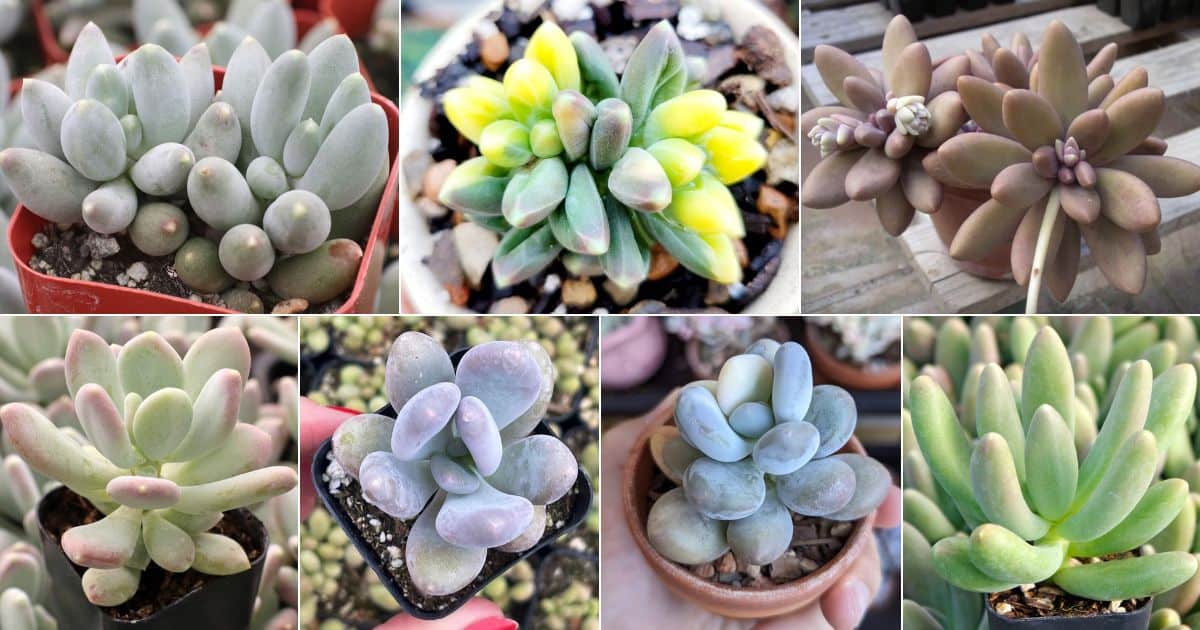
Indigenous to Mexico, this species has been the joy of many a grower thanks to its sprawling nature, extra thick with two ‘c’s leaves, and the very attractive blooms that it produces regularly.
Jump to:
- 1. Pachyphytum compactum
- 2. Pachyphytum oviferum
- 3. Pachyphytum hookeri
- 4. Pachyphytum glutinicaule
- 5. Pachyphytum 'Blue Haze'
- 6. Pachyphytum rzedowskii
- 7. Pachyphytum compactum 'Variegatum'
- 8. Pachyphytum 'Captain Jessop'
- 9. Pachyphytum oviferum 'Variegata'
- 10. Pachyphytum bracteosum
- 11. Pachyphytum viride
- 12. Pachyphytum clavifolia
- 13. Pachyphytum fittkaui
1. Pachyphytum compactum
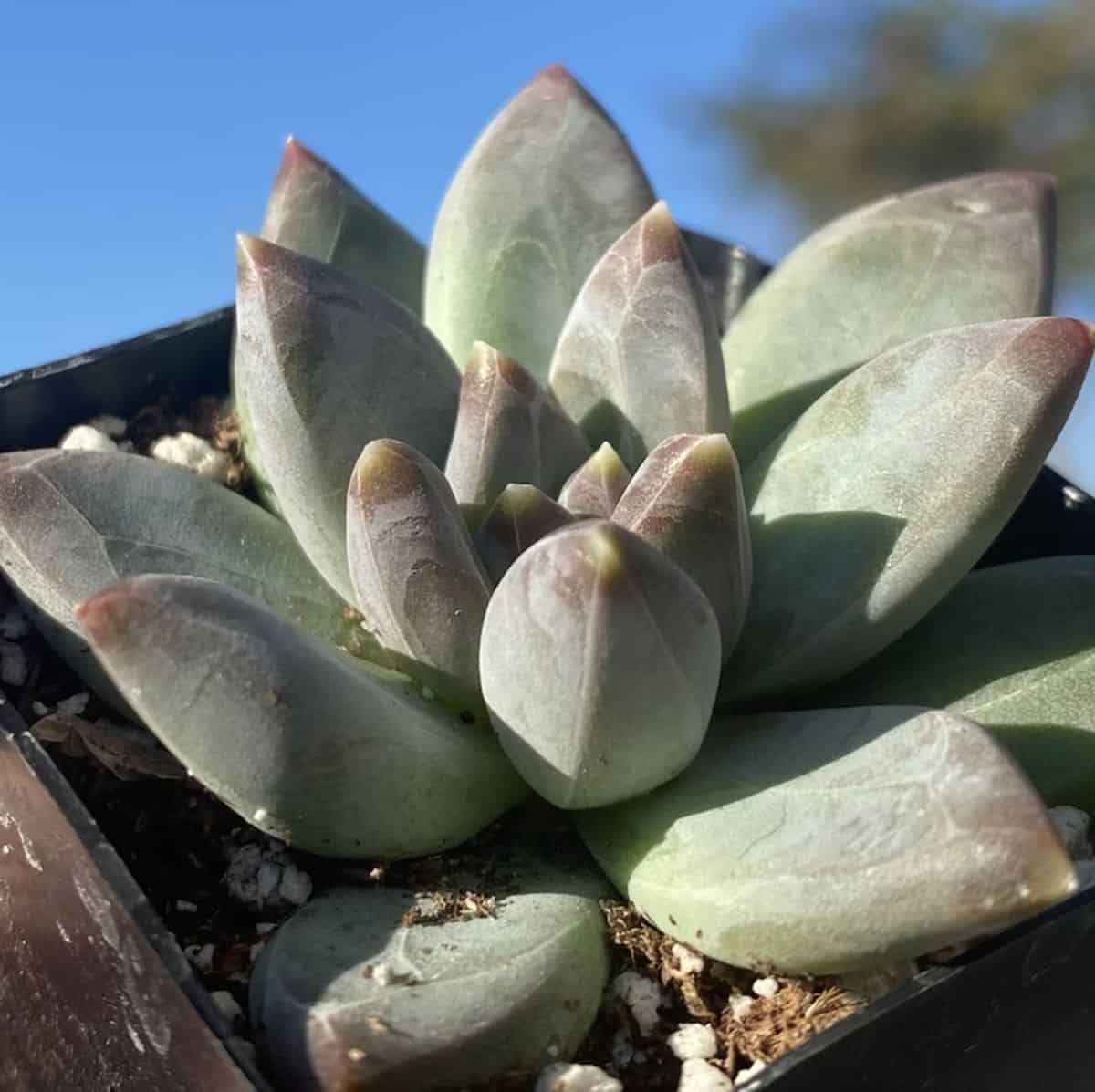
Buy it from:
| Maximum Height: | Up to 6 inches |
| Maximum Width: | Up to 16 inches |
| Watering Needs: | Only when soil is dry, more watering needed in the winter |
| Soil Needs: | Well-draining soil |
| Light Needs: | Full or partial sunlight |
| Hardiness Zone(s): | Zone 9 and up |
| Bloom Color and Shape: | Barrel-shaped, reddish orange with green or purple tips, grows on 12 inches blooming stalk |
| Stem Type: | Can be straight or bent depending on the weight of the rosettes, usually a foot in length. |
| Leaf Shape: | Very thick and linear, come to a point that can be tinged purple. Very compact rosettes. |
From my experience, Little Jewel is one of the easiest species to identify, thanks to how profoundly compact young rosettes are. As they age, they do begin to open up and show gorgeous light green delineation from where the leaves were pressed together: this is what makes each leaf look like a jewel!
2. Pachyphytum oviferum
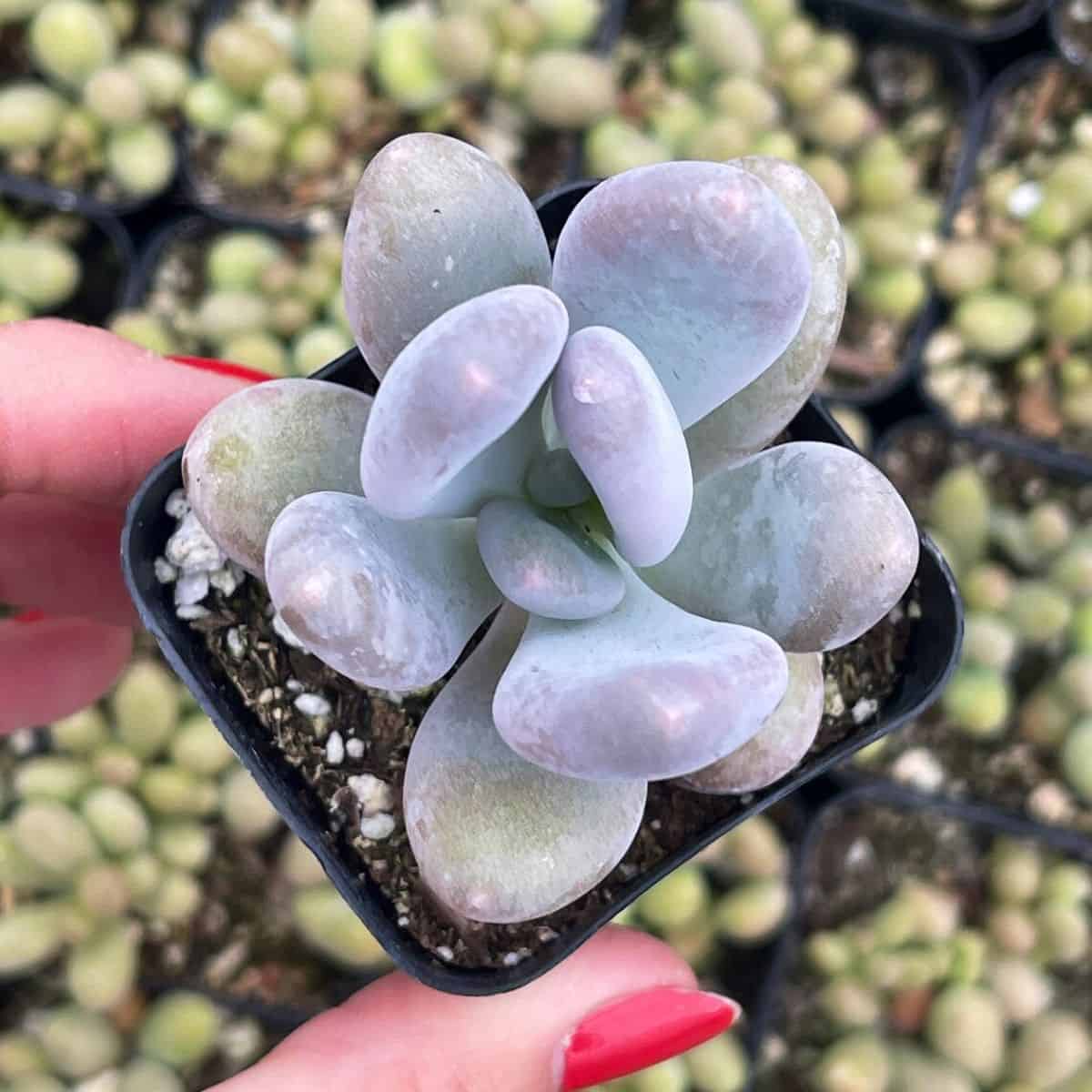
Buy it from:
| Maximum Height: | Rarely 8 inches |
| Maximum Width: | Up to 16 inches |
| Watering Needs: | Only when soil is dry, more watering needed in the winter |
| Soil Needs: | Well-draining soil |
| Light Needs: | Full or partial sunlight |
| Hardiness Zone(s): | Zone 10 and up |
| Bloom Color and Shape: | Bell-shaped with a cream color and a purplish spot toward the center (often hard to spot) |
| Stem Type: | Can get up to 8 inches tall, but rosettes often weigh the stems down. |
| Leaf Shape: | Very globose and thick; rosettes get up to 4 inches in diameter |
Moonstones are also one of the more easily identified species thanks to their very large and oval leaves. There are a few variants of moonstones that take on more pinkish colors; however, the standard color for this species is a light blue on younger leaves, with older leaves showing more green coloration. As with most species in this genus, there is a heavy coating of farina which gives it a ghastly and wonderful look!
3. Pachyphytum hookeri
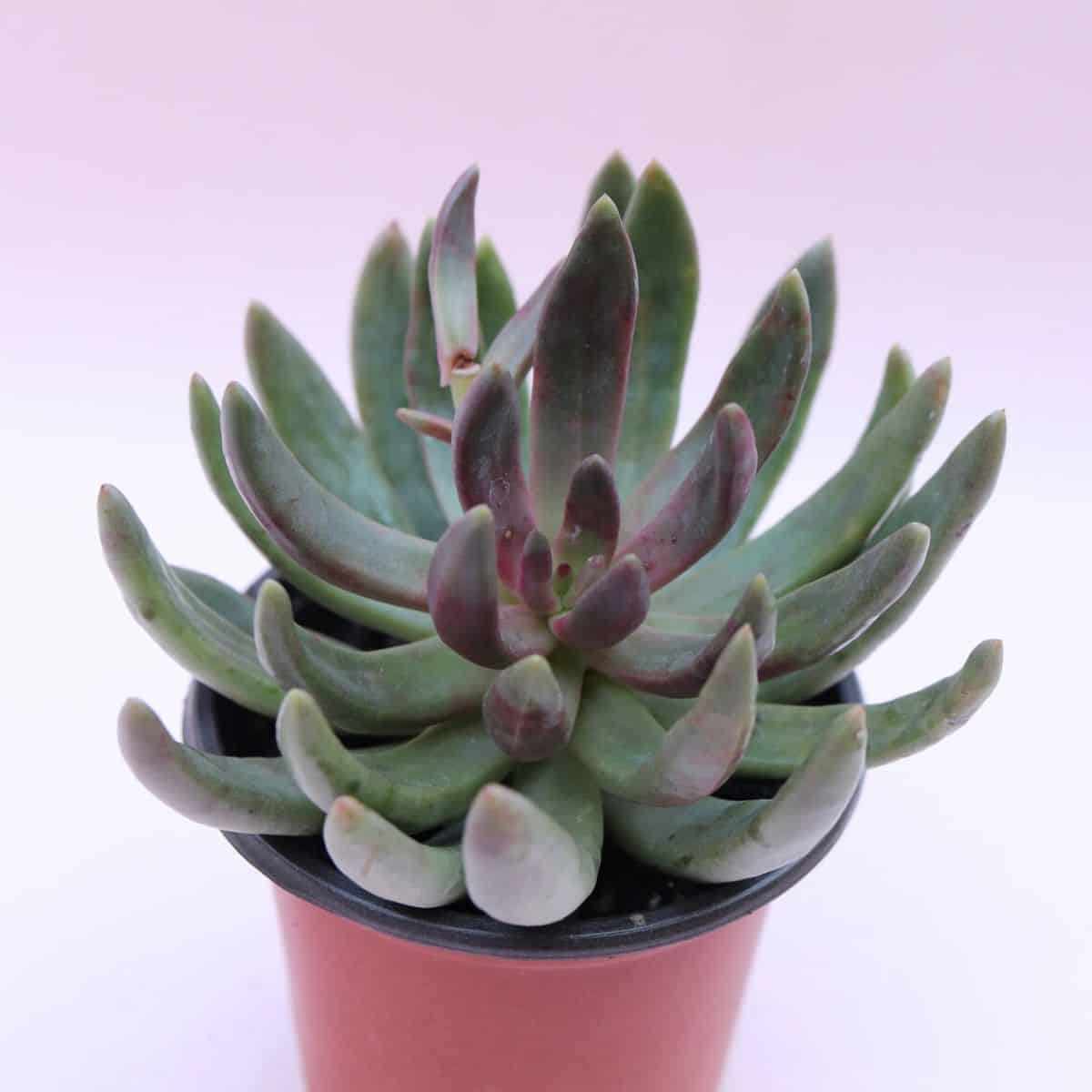
Buy it from:
| Maximum Height: | Up to 12 inches |
| Maximum Width: | Depending on stem reach and shape; can be up to 25 inches long |
| Watering Needs: | Only when soil is dry, more watering needed in the winter |
| Soil Needs: | Well-draining soil |
| Light Needs: | Full or partial sunlight |
| Hardiness Zone(s): | Zone 10 and up |
| Bloom Color and Shape: | On blooming stalks up to 14 inches tall, flowers are tubular to bell-shaped with light yellow or rose-colored petals |
| Stem Type: | Grows up to 12 inches tall but stays decumbent; longer stems can grow up to 25 inches long |
| Leaf Shape: | More spindle-shaped, very thick, and oval. Extends two inches out from the stem. |
P. hookeri is an interesting species as the leaves tend to grow in a spiral around the stem and fall off with age. Rather than distinct rosettes throughout the plant, only the tips have any form of a recognizable rosette. Like many in the genus, the tips will blush a different color, usually pink or violet, when slightly stressed. This adds a lovely contrast to the olive green leaves that are lacking in farina.
4. Pachyphytum glutinicaule

Buy it from:
| Maximum Height: | Rarely reaches 2 feet due to the weight of rosettes |
| Maximum Width: | Can grow up to four feet wide in mature plants |
| Watering Needs: | Only when soil is dry, more watering needed in the winter |
| Soil Needs: | Well-draining soil |
| Light Needs: | Full or partial sunlight |
| Hardiness Zone(s): | Zone 10 and up |
| Bloom Color and Shape: | Five-petaled bell shape: light pink in color with yellow centers. Blooming stalks can get up to 20 inches long |
| Stem Type: | Stems can be upright, bent, and rarely straight. |
| Leaf Shape: | Spoon-like with thicker ends; rosettes can get up to 5 inches in diameter |
This particular species looks much like an echeveria thanks to how the leaves open up more widely than sister species. The leaves are thin towards the base; however, the ends are much thicker and have a slight point to them that turns maroon. The stems aren't covered in farina; however, the leaves are, which protects them in full sun.
5. Pachyphytum 'Blue Haze'
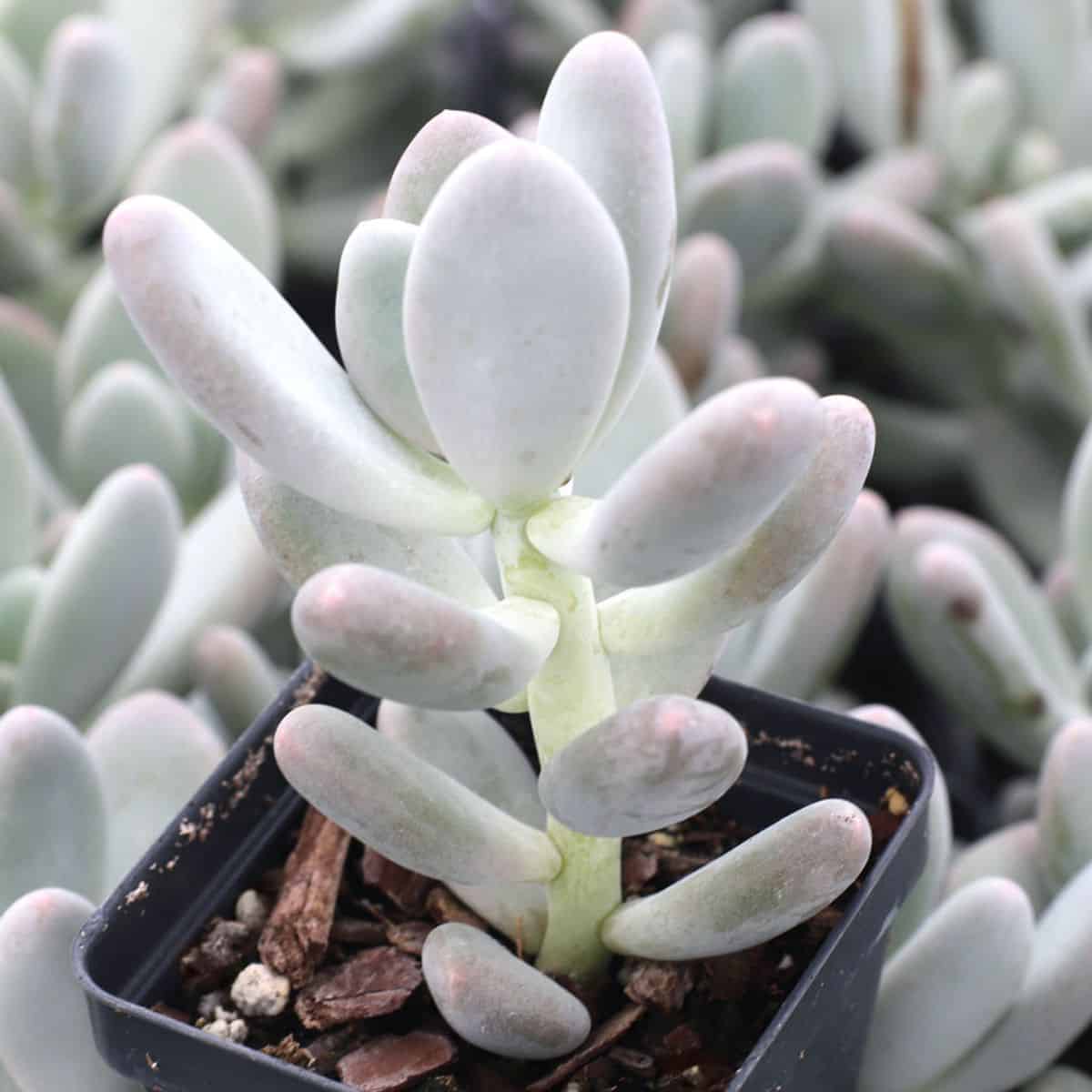
Buy it from:
| Maximum Height: | Depending on stem strength, up to 12 inches |
| Maximum Width: | Up to 24 inches |
| Watering Needs: | Only when soil is dry, more watering needed in the winter |
| Soil Needs: | Well-draining soil |
| Light Needs: | Full or partial sunlight |
| Hardiness Zone(s): | Zone 10 and up |
| Bloom Color and Shape: | Bell-shaped flowers with light rose-colored petals |
| Stem Type: | Can get up to 12 inches in length, branches at the base, and is very slow growing |
| Leaf Shape: | They look like worry stones with a slight depression in the center. Rosettes can get up to 4.5 inches in diameter. |
Also known as Blue Pearls, this variant or cultivar is still considered part of the Moonstone group of pachyphytum. What separates Blue Haze out is that first, the leaves are further spaced apart along the stem, and second, there’s a depression in the middle of the leaf that gives them a slight upward turn. While the leaves are still thick and covered with farina, they are in no way as thick as P. oviferum.
6. Pachyphytum rzedowskii
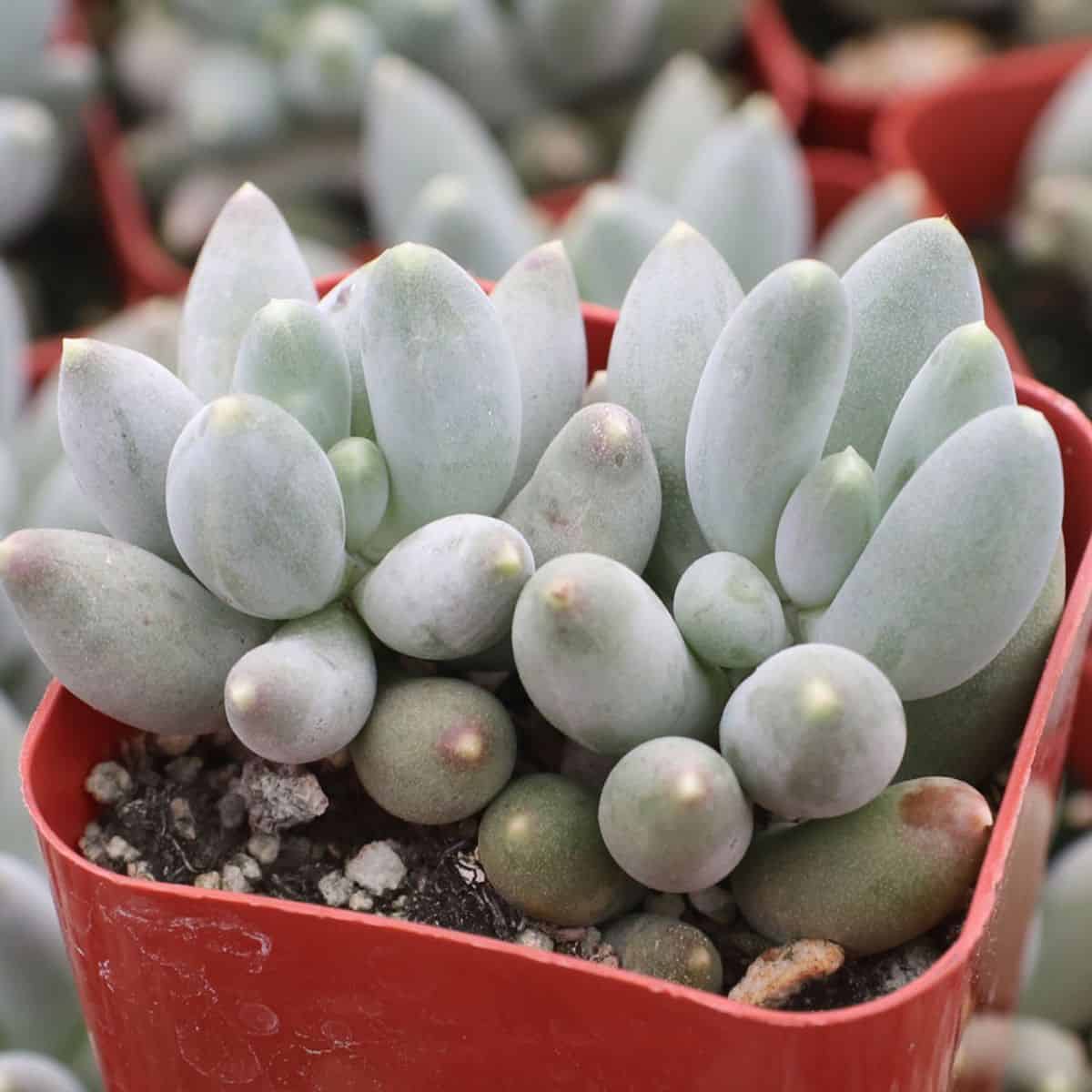
Buy it from:
| Maximum Height: | Up to 12 inches |
| Maximum Width: | From 12 inches to 24 inches |
| Watering Needs: | Only when soil is dry, more watering needed in the winter |
| Soil Needs: | Well-draining soil |
| Light Needs: | Full or partial sunlight |
| Hardiness Zone(s): | Zone 9 and up |
| Bloom Color and Shape: | Generally light green, tend to have a red spot in the center; bell-shaped |
| Stem Type: | Up to 12 inches long and almost an inch wide |
| Leaf Shape: | Spiral arrangement along the stem with leaves that take on a spindle shape |
I find this species fun because the leaves tend to stay on the stems longer, which makes it look more bush-like than other species; Unlike other pachyphytum, the rosettes are rather disorganized but definitely prominent in older specimens. Out of all of the species in this selection, this one has the thickest coating of farina and will be able to handle direct sunlight the best.
7. Pachyphytum compactum 'Variegatum'
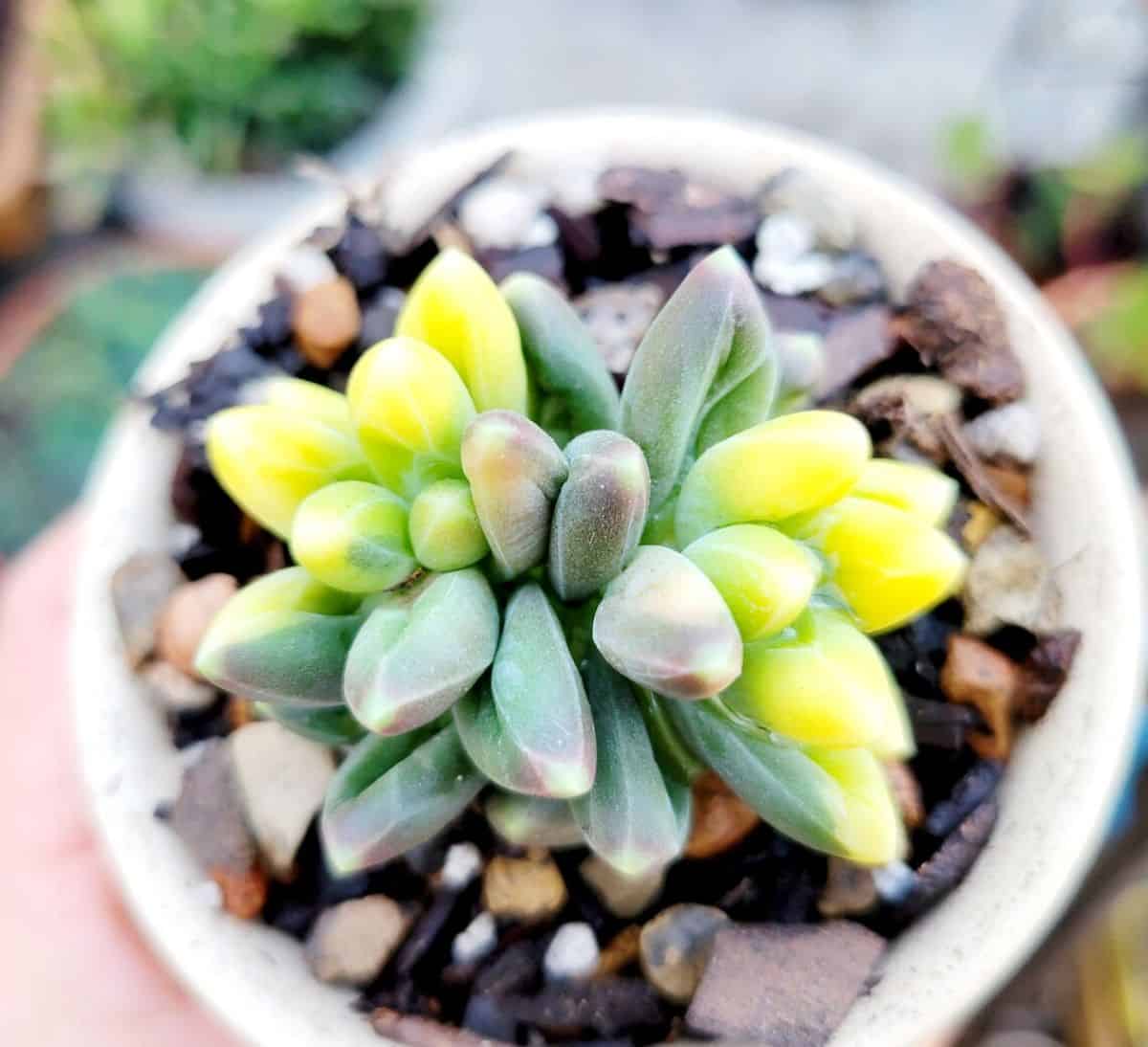
Buy it from:
| Maximum Height: | Up to 6 inches tall |
| Maximum Width: | Can be between 6 and 12 inches |
| Watering Needs: | Only when soil is dry, more watering needed in the winter |
| Soil Needs: | Well-draining soil |
| Light Needs: | Full or partial sunlight |
| Hardiness Zone(s): | Zone 9 and up |
| Bloom Color and Shape: | Barrel-shaped, reddish orange with green or purple tips, grows on 12 inches blooming stalk |
| Stem Type: | Can be straight or bent depending on the weight of the rosettes, usually a foot in length. |
| Leaf Shape: | Very thick and linear, come to a point that can be tinged purple. Very compact rosettes. |
You can’t talk about Little Jewel without talking about the variegated version. The variegated species only have one difference, and that is the gorgeous mottling that occurs thanks to a genetic mutation that turns off the expression of chlorophyll in certain areas of the plant. It is very rare to get a completely yellow version of this variant.
8. Pachyphytum 'Captain Jessop'
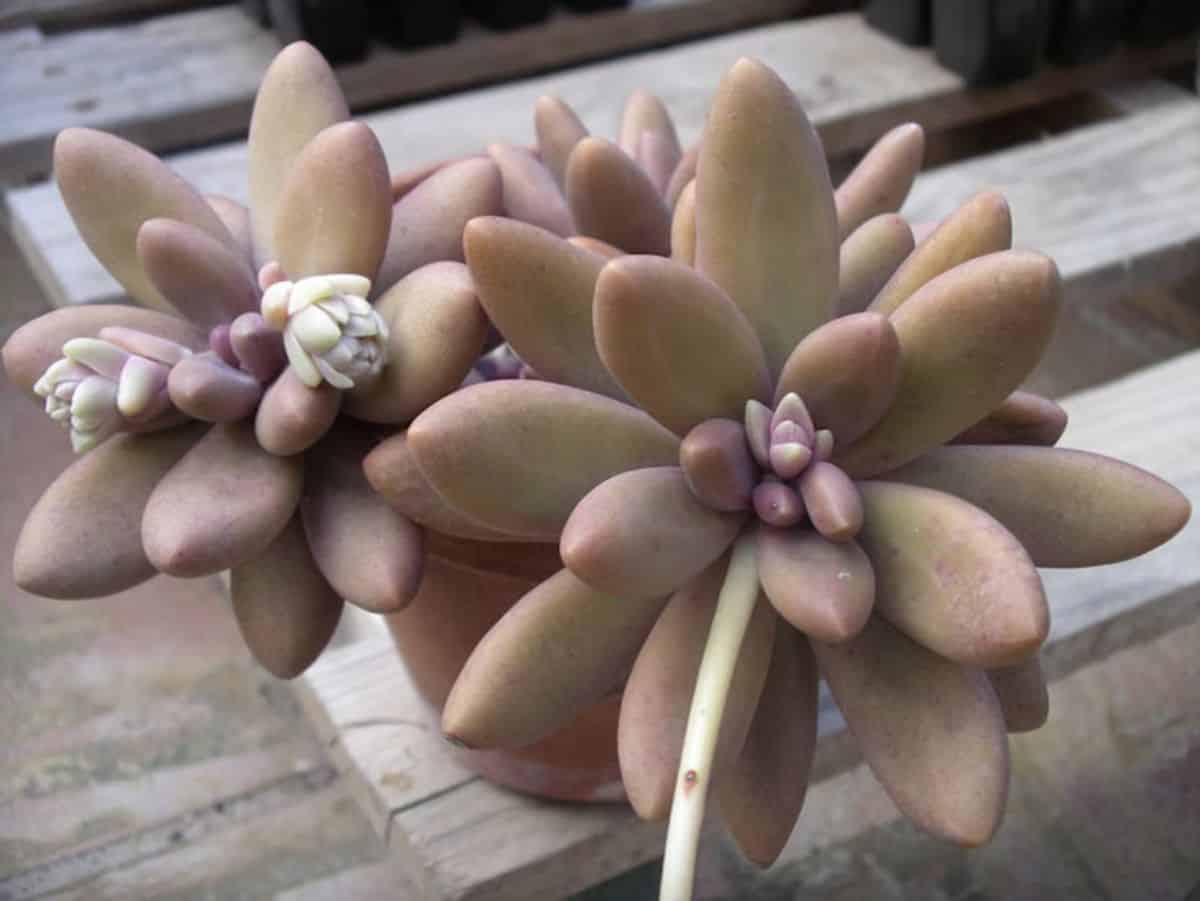
Buy it from:
| Maximum Height: | Under 5 inches |
| Maximum Width: | Under 5 inches |
| Watering Needs: | Only when soil is dry, more watering needed in the winter |
| Soil Needs: | Well-draining soil |
| Light Needs: | Full or partial sunlight |
| Hardiness Zone(s): | Zone 9 and up |
| Bloom Color and Shape: | Red-orange bell-shaped flowers |
| Stem Type: | Very short and stocky compared to other species. |
| Leaf Shape: | Looks like stubby fingers that flatten as they age; rosettes can be up to 8 inches in diameter |
There are some species that have an interesting history that come along with their breeding, and this is one. One of the founders of the English branch of the National Cactus and Succulent society, Captain Jessop, decided to cross P. oviferum and P. viride. The cross yielded a highly colorful, farina-lacking species that changes into a series of rusty oranges, reds, and greens.
9. Pachyphytum oviferum 'Variegata'
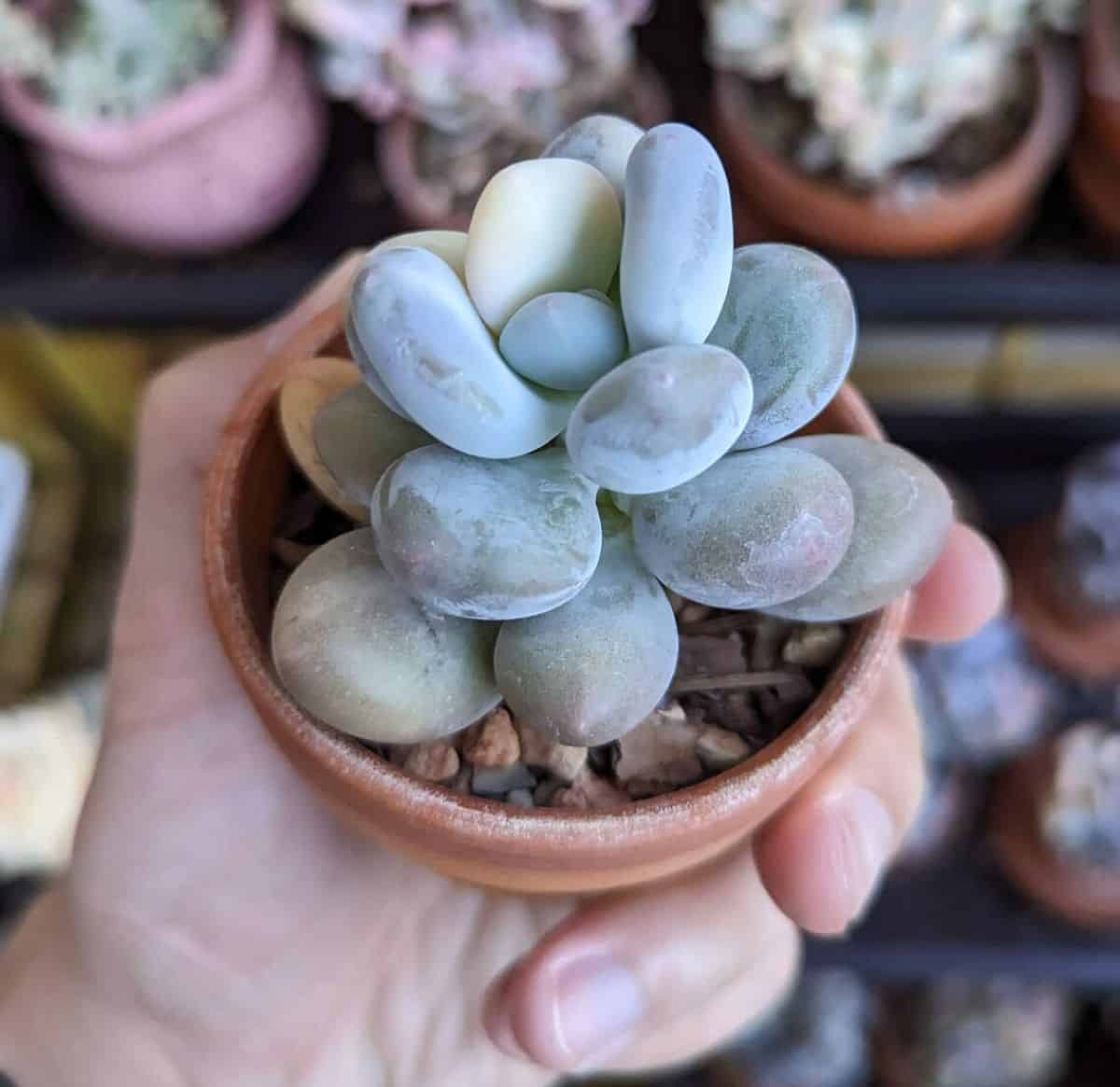
Buy it from:
| Maximum Height: | Up to 4 inches |
| Maximum Width: | Up to 12 inches |
| Watering Needs: | Only when soil is dry, more watering needed in the winter |
| Soil Needs: | Well-draining soil |
| Light Needs: | Full or partial sunlight |
| Hardiness Zone(s): | Zone 10 and up |
| Bloom Color and Shape: | Bell-shaped with a cream color and a purplish spot toward the center (often hard to spot) |
| Stem Type: | Can get up to 8 inches tall, but rosettes often weigh the stems down. |
| Leaf Shape: | Very globose and thick; rosettes get up to 4 inches in diameter |
Variegated moonstones are a little difficult to find because of the variety of moonstone colors there are. You can find variegated blue moonstones, variegated pink moonstones, and the list goes on. As with most variegated species, you will hardly find a fully yellow species, and the mottling will generally only occur on the leaves.
10. Pachyphytum bracteosum
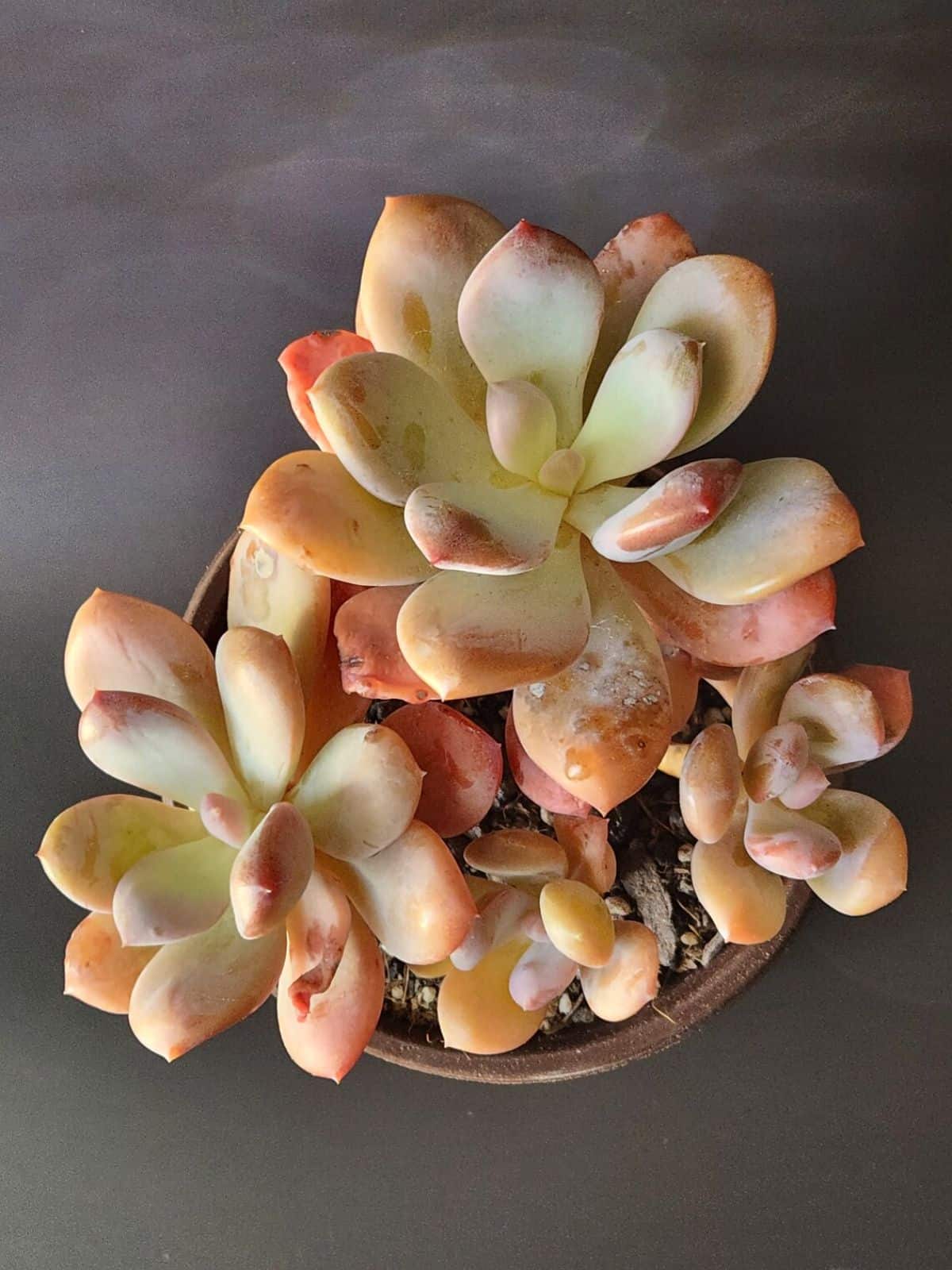
Buy it from:
| Maximum Height: | Up to a foot, depending on the rosette size |
| Maximum Width: | Up to a foot |
| Watering Needs: | Only when soil is dry, more watering needed in the winter |
| Soil Needs: | Well-draining soil |
| Light Needs: | Full or partial sunlight |
| Hardiness Zone(s): | Zone 10 and up |
| Bloom Color and Shape: | Bell-shaped atop a pink blooming stalk, the petals are light pink along the edges and darken to a hot pink toward the center |
| Stem Type: | Thicker and up to a foot long but tends to stay low along the ground |
| Leaf Shape: | Nearly an inch thick and paddle-shaped |
Silver Bracts belongs to the Moonstone group but is far more impressive in size. Most moonstone plants are delicate and grow on delicate stems. Not so with P.bracteosum. I had to double-check this research because I couldn't believe it; the leaves can get up to 5.6 inches thick. You read that right, thick. Not wide, not long, but thick. It’s impressive!
11. Pachyphytum viride
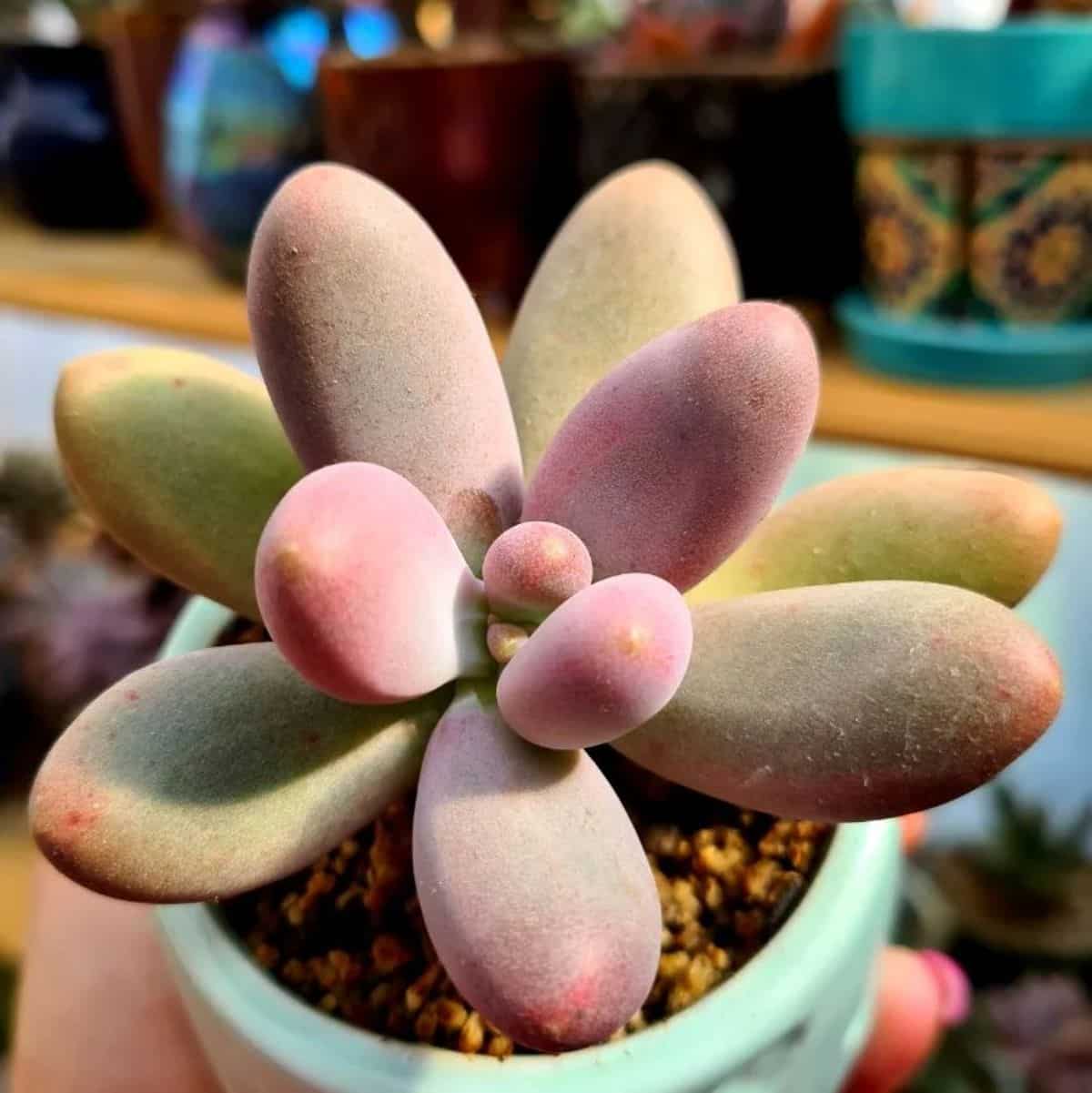
Buy it from:
| Maximum Height: | Depends on the weight of the rosettes |
| Maximum Width: | Stems can get up to 3 feet long |
| Watering Needs: | Only when soil is dry, more watering needed in the winter |
| Soil Needs: | Well-draining soil |
| Light Needs: | Full or partial sunlight |
| Hardiness Zone(s): | Zone 10 and up |
| Bloom Color and Shape: | Grows on 14 inches of the non-branching blooming stalk; flowers are bell-shaped, white toward the center with light purple towards the end. |
| Stem Type: | Stem can get up to 3.3 feet long and 1.5 inches wide. |
| Leaf Shape: | Finger-like without pressure marks and can get up to four inches in length |
Officially among cultivars and true species, P. viride is considered the largest species of pachyphytum to date. The stems are thick and support the massive weight of many different branches and leaves. It does basally branch more often than not, and the leaves are a gorgeous combination of reddish-purple and a yellowish-green. Definitely, one to add to the books!
12. Pachyphytum clavifolia
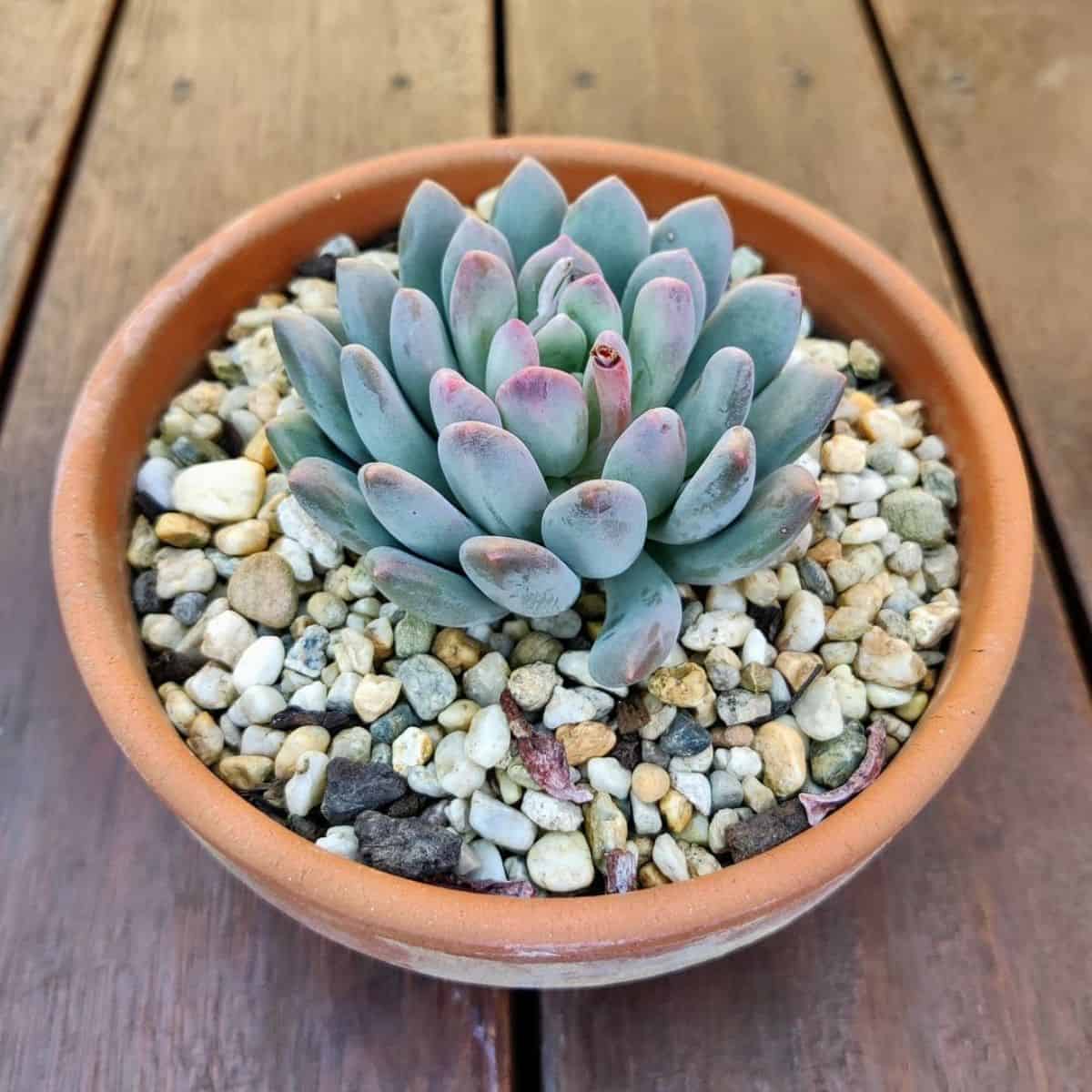
Buy it from:
| Maximum Height: | Up to 6 inches tall |
| Maximum Width: | Depends on the length of the stems |
| Watering Needs: | Only when soil is dry, more watering needed in the winter |
| Soil Needs: | Well-draining soil |
| Light Needs: | Full or partial sunlight |
| Hardiness Zone(s): | Zone 10 and up |
| Bloom Color and Shape: | Orange and red bell-shaped flowers |
| Stem Type: | Stems branch and get up to six inches long |
| Leaf Shape: | Like a spoon with a slight depression and very thick |
This species goes by a few names since it is a cross between a pachyphytum and an echeveria species. In some cases, you may hear this species called Echeveria ‘Gray Red,’ which is equally accurate. What makes this species less echeveria and more pachyphytum is the fact that the leaves maintain the distinct spoon shape; while the leaves aren’t as thick as other species, they are still very pachyphytum looking.
13. Pachyphytum fittkaui

Buy it from:
| Maximum Height: | Over 12 inches |
| Maximum Width: | Depends on plant stems and branching. |
| Watering Needs: | Only when soil is dry, more watering needed in the winter |
| Soil Needs: | Well-draining soil |
| Light Needs: | Full or partial sunlight |
| Hardiness Zone(s): | Zone 10 and up |
| Bloom Color and Shape: | Bell-shaped |
| Stem Type: | Thick, sprawling stems that can get over one foot in the wild. |
| Leaf Shape: | Finger-like and lance-shaped with a slight tip |
If there were two pachyphytum that I could pick that look like they made P. fittkaui, it would be Little Jewel and P. viride. Watermarks and farina show where the leaves were compact and growing tightly against one another; In the same way, the leaves look more thick and finger-like from the side. As with others in the genus, this species will blush purple or red at the ends when in the right conditions (increased environmental stressors), which adds that lovely touch of color so loved in the Pachyphytum genus.

